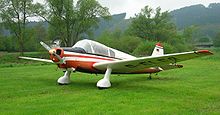Terminal Kl 107
| Terminal Kl 107 | |
|---|---|

|
|
| Type: | Light aircraft |
| Design country: | |
| Manufacturer: |
Light aircraft construction Klemm |
| First flight: |
1940 |
| Production time: |
1940-1961 |
| Number of pieces: |
6 + 55 |
The Klemm Kl 107 is a civil touring and training aircraft from Leichtflugzeugbau Klemm GmbH .
history
The aircraft was designed in 1940 based on the construction of the Klemm Kl 105 . The Kl 107 is also a cantilever low -wing aircraft in all-wood partial shell construction with a rigid normal chassis and, compared to the Klemm 105, structurally reinforced, enlarged and equipped with more powerful motors. In addition, landing flaps were installed. The two-man crew sit side by side in a closed cabin. A four-cylinder in-line Hirth HM 500 engine with 105 hp serves as the drive . The first flight took place in mid-1939, whereby on July 5, 1939, Klemms chief pilot Helmut Kalkstein with the V1 (D-EXKL) crashed due to a broken wing due to a material defect and was killed. Due to the war, only six of the 20 machines ordered were manufactured by 1941.
After the Second World War, Ludwig Bölkow and Hansjürgen Klemm suggested resuming production in 1954 . The first of these Kl 107A (still identical to the original machines) had its maiden flight on September 4, 1956. In 1959, the modified and now three-seater Klemm Kl 107B followed in wood construction with a 110 kW Lycoming O-320 engine, which was manufactured in series (26 units) by the newly founded Bölkow subsidiary Apparatebau Nabern GmbH . Since the rights had passed to Bölkow, he developed the aircraft further and so shortly afterwards the Kl 107C came onto the market. This had a wider landing gear, a wider fuselage, a controllable pitch propeller and could be equipped with a device for towing gliders. Only 29 units were built up to 1961, which was due to the outdated wooden construction and the narrow cabin. In order to improve sales, the 107C was transformed into the 107D (an even larger four-seater with a more powerful engine) in 1958/59 , which was practically a new design. The prototype with Lycoming four-cylinder engine O-360A with 132 kW had its first flight on October 10, 1960 in Nabern and was renamed in May 1961 first in Bölkow F207 and then in July 1961 in Bölkow Bo 207 . In the same year the second prototype and the first series machine of the Bo 207 took part in the Germany flight.
Technical specifications
| template | Clamp
Kl 107 |
Clamp
Kl 107 A |
Clamp
Kl 107 B |
Clamp
Kl 107 C |
Bölkow
Bo 207 |
Bölkow
Bo 207 B |
|---|---|---|---|---|---|---|
| Construction year | 1940 | 1956 | 1958 | 1959 | 1960 | 1962 |
| crew | 1 + 1 (2) | 1 + 2 | 1 + 3 | |||
| span | 10.87 m | 10.84 m | 10.81 m | |||
| length | 8.16 m | 8.30 m | ||||
| Wing area | 15.10 m² | 14.60 m² | 15.40 m² | |||
| Wing extension | 7.8 | 8.0 | 7.8 | |||
| Empty mass | 480 kg | 530 kg | 570 kg | 625 kg | 700 kg | 740 kg |
| Max. Takeoff mass | 740 kg | 860 kg | 940 kg | 970 kg | 1200 kg | 1240 kg |
| Top speed | 190 km / h | 185 km / h | 220 km / h | 235 km / h | 255 km / h | 250 km / h |
| Cruising speed | 176 km / h | 165 km / h | 180 km / h | 205 km / h | 235 km / h | 225 km / h |
| Rate of climb | 3.4 m / s | 3.2 m / s | 4.0 m / s | 3.6 m / s | 3.3 m / s | |
| Service ceiling | 4200 m | 3000 m | 4400 m | 4150 m | 4300 m | 4000 m |
| Range | 670 km | 760 km | 820 km | 1250 km | 1150 km | |
| Engines | Hirth HM 500 (105 HP) | Continental C90 (90 HP) | Lycoming O-320 A (150 hp) | Lycoming O-360 A (180 hp) | ||
literature
- Heinz J. Nowarra : The German Air Armament 1933-1945. Bernard & Graefe Verlag, Koblenz 1993, ISBN 3-7637-5464-4 .
Web links
- LBA data sheet of the Klemm KI 107A (PDF; 70 kB)
- LBA data sheet of the Klemm KI 107B (PDF; 81 kB)
- LBA data sheet of the Klemm KI 107C (PDF; 81 kB)
- LBA data sheet for Bölkow 207 (PDF; 73 kB)
- LBA data sheet for Bölkow 207T (PDF; 83 kB)
- www.quax-flieger.de : A Klemm 107 B of the Association for the Promotion of Historic Aircraft

